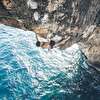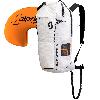Haute route Chamonix - Zermatt: the Queen of all ski mountaineering traverses

 1 / 4
1 / 4 Nicolò Berzi
Nicolò Berzi
Multi-day traverses have always been at the heart of ski mountaineering, and the Chamonix – Zermatt Haute Route, first carried out by the famous Mountain Guide Toni Gobbi in the 1950’s, is one of the most popular and fascinating traverses in the Alps.
The "high routes" cover enormous distances, and in winter the sensation of traveling on skis is something quite unique. The journey becomes an end in itself, and the "icing on the cake" are by no means the fantastic descents, but the actual terrain crossed. Looking back at the distance covered throughout the day and planning the next stage offers immense satisfaction and deep, new sensations. Once in the world of the Haute Route, you’ll find it hard not to dream about the next outing.
Obviously there's the other side of the coin, which some consider a pleasurable aspect of this journey. For example, the considerable weight of the rucksack, which must contain spare clothing and ski mountaineering equipment. And other mountaineering gear, such as ice axe, crampons, harness, and rope since often the terrain is at altitude and corsses glaciers and steep descents where you need to rope up. And of course you need maps, a compass even if GPS seems to be relegating the magnetic needle into the museum.
And it must be said that this traverse requires considerable mountaineering experience, and the capability of turning back if need be. Changing snow and weather conditions may be the order of the day, and you may well have to make sudden, important decisions about alternatives to keep risks low, or even give up completely. Multi-day traverses require knowledge, understanding, experience and the capacity to make decisions independently, rather than simply following the group ahead. It is because of this that the long traverses should remain the flagship of ski mountaineering,
THE TRAVERSE
Although this traverse does not reach the summit of particularly high peaks (the highest mountain is Pigne d’Arolla 3796m), it is nevertheless demanding and some of the stages may be found long and tiring. The real objective is Zermatt but sometimes this is not possible due to weather and snow conditions. There are of course countless variations, depending on weather, fitness and ability. The best time of year is in April and May, and consequently these months tend to be the most popular. Earlier in the year there are less people and powder snow but a greater risk of avalanches. The itinerary described here is also a splendid trekking route in summer.
Day 1
The first day is dedicated to reaching Briga. Park the car here and spend the night in a hotel, to then catch the train or bus to Chamonix early the next morning.
Day 2
Reach Argentiere by bus and take the Grands Montets (3297m) cable car. From the top station ski down to the Argentiere glacier. Cross this to the base of the steep slopes that lead up to Col du Chardonnet 3223m). Now descend steeply (many rope-up for this first section) to reach the plateau of the glacier di Saleina. Put on climbing skins once more to reach Fentre de Saleina (3261m). Ski down the other side of this col and, with a final short ascent, reach Cab. Du Trient (3170m).
Day 3
Leave the hut and descend along the Trient glacier to lose about 300m in altitude before turning off right towards Col des Escandies (2796m) which leads to Vallone d’Arpette and on down the fantastic descent to Champex (1498m). Take the bus from this small village to Orsieres and then the train to Martigny and then a bus once more to Arolla. This is done in order to avoid the traverse through the Grand Combin massif – splendid and highly recommended if more time is available).
Day 4
Skilifts from Arolla lead to the top of the pistes; proceed to Pas de Chevre 2855m and the steep 40m ladder, to then reach the welcoming Cabanne de Dix (2928m). Spend the night here. By taking the skilifts from Arolla (saving 500m height gain) there is plenty of time to climb the beautiful La Luette (3548m) that rises up behind the refuge. The panorama and descent are fantastic.
Day 5
Leave Cab. De Dix and cross the Cheilon glacier to climb up the slopes towards Col de la Serpentine, before turning left to reach the summit of Pigne d’Arolla. The panorama from here is truly amazing. Steep slopes - the icing on today’s cake - lead quickly down to Cab. Des Vignerttes (3185m) below.
Day 6
The final stage is also the longest. From Cab des Vignettes descend slightly to then cross the entire Mont Collon glacier all the way to Col de l’Eveque. A brief descent leads to beneath Col du Mont Brule (3213m); climb up to this and over the col (on foot) to reach the Valpelline basin above Rif. Aosta. From the col descend once more, traversing beneath the rocks . Put on the climbing skins for the last time and climb up to Col de Valpelline (3568m) to start the long and splendid descent to Zermatt. From Zermatt take the train to return to Briga.
Getting there
The starting point for this itinerary is Briga.
Best time of year
The best time of year is in spring, between April and May, during which the travese is extremely popular. Earlier on there are less people and the snow tends to be powdery, but the avalanche danger increases. The route described here, with a few variants, can be carried out in summer.
www.meteofrance.com
Maps
Indispensabile 50.000 "Mont Blanc – Grand Combin" n° 5003 and "Matterhorn – Mischabel" n° 5006.
Alternatlively, 25.000 "Col de Balme" n°1344, "Orsieres" n° 1345 and "Matterhorn" n°1347 . Perhaps the best solution are the maps 50.000 n° 282 S "Martigny" e 283 S "Arolla".
Links and further info
Weather 0041/91162
Cable car des Grands Montets 0033/450540071
Cab. du Trient 0041/277831438
Cab. des Dix 0041/272811523
Cab. des Vignettes 0041/272831322
Internet: www.chamonix.com, www.sbb.ch (Swiss bus and train times), www.guidealpine.lombardia.it



 Copia link
Copia link
























